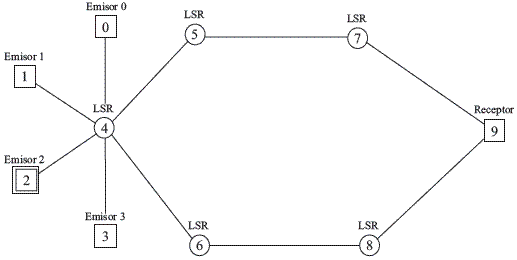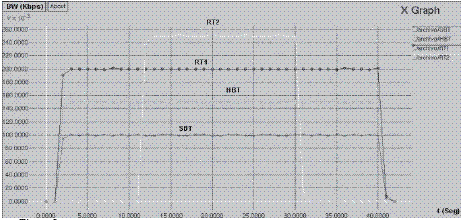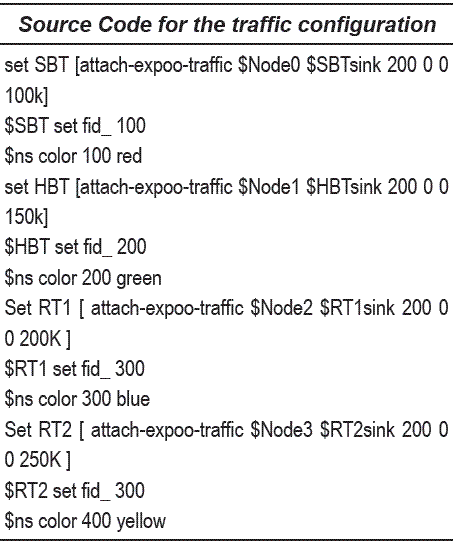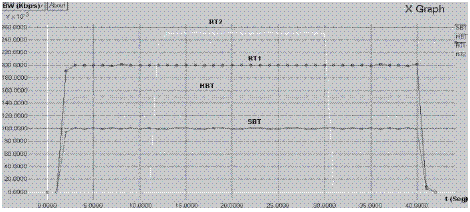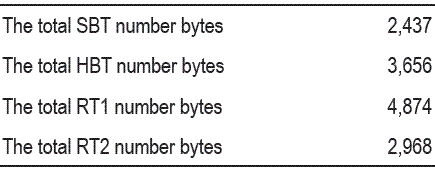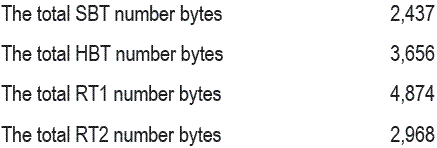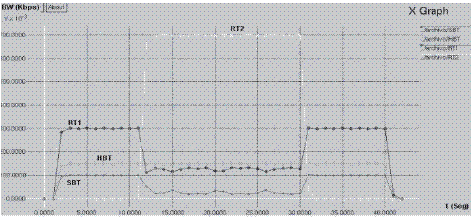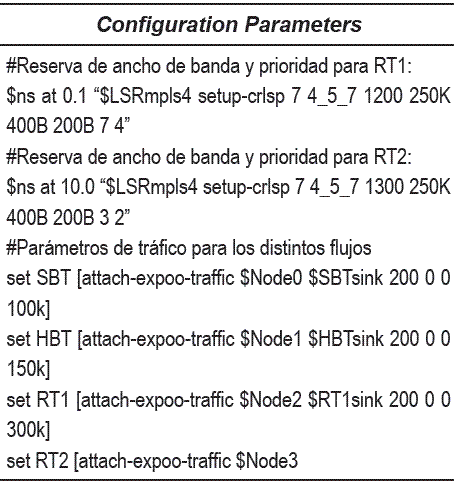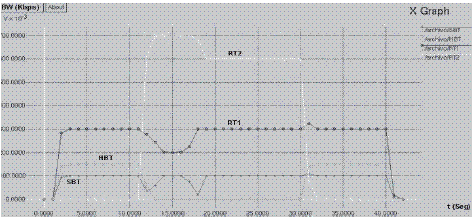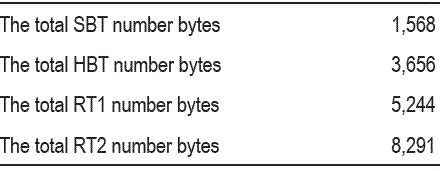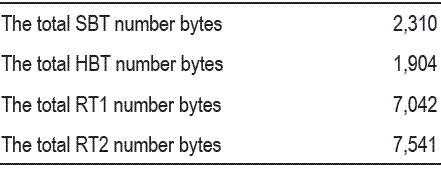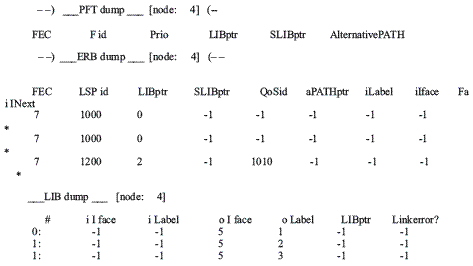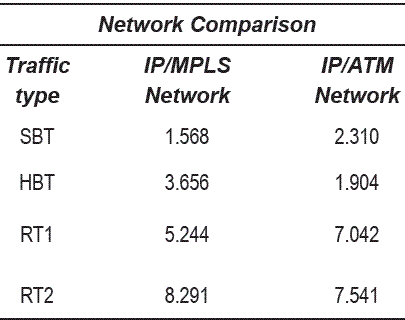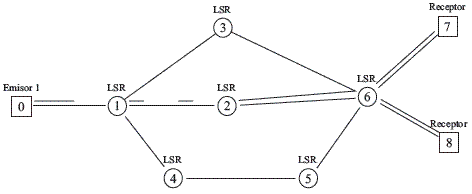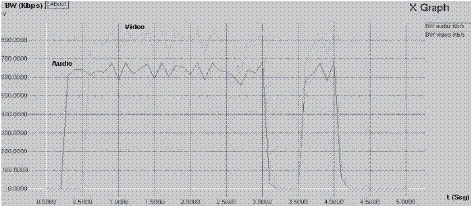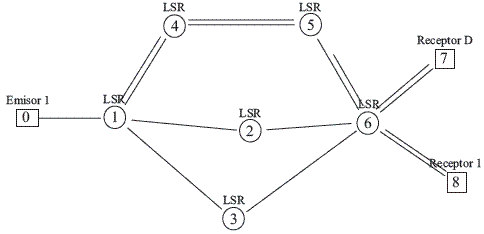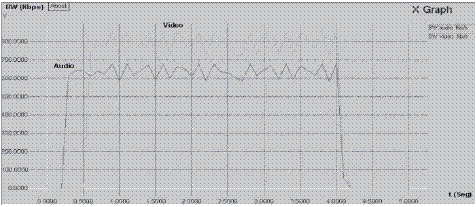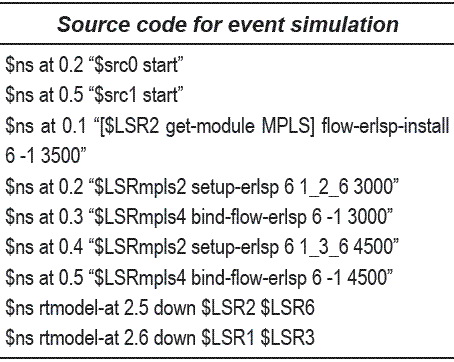Services on Demand
Journal
Article
Indicators
-
 Cited by SciELO
Cited by SciELO -
 Access statistics
Access statistics
Related links
-
 Cited by Google
Cited by Google -
 Similars in
SciELO
Similars in
SciELO -
 Similars in Google
Similars in Google
Share
Revista Facultad de Ingeniería Universidad de Antioquia
Print version ISSN 0120-6230On-line version ISSN 2422-2844
Rev.fac.ing.univ. Antioquia no.50 Medellín Oct./Dec. 2009
Performance evaluation in MPLS/IP datanetworks
Evaluación del desempeño en redes de datos MPLS/IP
Danilo López, Octavio Salcedo, César Hernández*
Grupo de investigación Internet Inteligente, Universidad Distrital Francisco José de Caldas. Carrera 7 No 40-53. Bogotá, D. C. Colombia
Abstract
This paper shows the results of a study on data transmission with different characterization (best-effort, high-priority best-effort and two types of real time traffic) through the switching protocol for multi-protocol labels in IP networks, compared to the IP data transmission using the Asynchronous Transfer Mode. This study illustrates the best performance the MPLS shows under a network congestion. The NS_2 discrete event simulator was used as experimentation tool.
Keywords: Asynchronous transfer mode, Constraint-based label distribution protocol, internet protocol, label edge routers, label switching routers, multiprotocol label switching
Resumen
Este documento muestra los resultados de un estudio sobre la transmisión de datos con diferente caracterización (mejor esfuerzo, alta prioridad - mejor esfuerzo y dos tipos de tráfico en tiempo real) a través del protocolo de conmutación de etiquetas multi-protocolo en redes IP, comparado con la transmisión de datos IP usando el Modo de Transferencia Asíncrona. Este estudio ilustra el mejor rendimiento de MPLS en una congestión de la red. Se utilizó el simulador de eventos discretos NS_2 como herramienta experimental.
Palabras clave: Encaminador de conmutación de etiquetas, encaminador de etiquetas frontera, encaminamiento basado en restricciones del protocolo de distribución de etiquetas, conmutación de etiquetas multiprotocolo, modo de transferencia asíncrona, protocolo de internet
Introduction
Routers currently direct the packages arriving to their ports based on routing tables that are built either statically or dynamically. Each package has a source direction field as well as a destination direction. The latter is analyzed by the router in order to determined the output port [1, 2]. This task is repeated in all the network nodes the package passes through so as to arrive its destination [1, 2]. This over-processing in each node of the network results in: delays in the package directioning, congestion, and a decrease in service quality [3]. The proposed solutions include the Resource ReSerVation Protocol (RSVP) and the Multi-Protocol Label Switching Protocol (MPLS) [4]. However, the former is not a solution for scalable networks. The latter aims to integrate the switching in layer 2 with the routing in layer 3 by exchanging labels thus, enhancing the price/profitability ratio [3]. It is done thanks to the scalability and flexibility of the network layer, which allows providing new services [4]. In this paper, an IP/MPLS network behavior to distribute traffic with priority will be presented. Then, it will be compared to an IP/ATM network. To develop the different simulations, the NS_2 discrete event simulator has been used [3, 5].
Multi-Protocolo Label Switching (MPLS)
This protocol functioning is based on label the packages, which expedites each package treatment in every node within the MPLS domain [6]. This mechanism allows an explicit routing. It consists of Label Edge Routers (LER) and Label Switching Routers (LSR) [7] that have a control plane and data plane [8]. In addition to manage the routing table building, the label exchange, and the data signalling, the LSR type also is capable to apply flexible routing based on the flow allocation on end-to-end routes within an autonomous domain [9, 10].
Routing combination based on restrictions (CRLDP) [11, 12] and MPLS allows the service quality implementation by choosing restricted routes based on the link features, the leap amount, the maximum lag, among other things [12, 13].
Experimentation and results
Audio and video applications in real time require some transmission maximum lag allowed by the network. They cannot be met to a large extent because of the lags in the package processing, which must be done in all the route nodes resulting in congestion and generating some traffic jams in the network critical nodes. A potential solution is to reserve the resource available in a network (like band width, lag, package loss, etc.). However, this is not a good solution for scalable networks [4]; another solution consists in searching alternative clear routes for the priority traffic ensuring some requirements.
Hereinafter, this paper describes the scenarios of simulations conducted on IP/MPLS and ATM/IP networks and obtained results are also displayed. To develop the different simulations, the NS_2 discrete event simulator has been used [5].
Figure 1 shows a possible scenario (made up by four traffic generators, 2 LSR and one receptor), in which a congestion may happen at the LSR4 router as there are four different incoming traffic sources: Simple Best-effort Traffic (SBT), Highpriority Best-effort Traffic (HBT) and two types of traffic in real time (RT).
Figure 1 Congestion at the LSR4 node
The band width in each link is 1 Mbps; emitter 0 transmits at a constant bit rate of 100 Kbps, emitter 1 at 150 Kbps, emitter 2 at 200 Kbps, and emitter 3 at 250 Kbps, which means that the band width is guaranteed for the different flows as the traffic total sum does not exceed the band width set in the links. It is graphically shown in Figure 2.
Figure 2 Guaranteed band width used by the traffic different types in the IP/MPLS network
It is worth to note how Figure 1 shows the Label Switched Path (LSP) route establishment through the Label Request (nodes 4-6) and the Label Mapping (nodes 4-5) messages in the MPLS backbone.
The following code (Table 1) allows to show some simulation important aspects like the sending route establishment and emitted traffic for each source.
Table 1 Source code for the traffic configuration
The traffic behavior over an IP/ATM network with the same features is shown In Figure 3.
Figure 3 Guaranted band width used by the traffic different types in the IP/ATM network
It can be seen that like in the IP/MPL is lower than the link capacity.
The amount of packages received in the IP/MPLS network as well as in the IP/ATM network is shown in Tables 2 and 3.
Table 2 Amount of package received in IP/MPLS
Table 3 Amount of package received in IP/ATM
Figure 4 shows the MPLS-CRL_DP efficiency respecting the guaranteed band width reservation for one of the real time traffic type (RT2) incoming to the Figure 1 network. In this case, it has been assumed to have congestion in the LSR1 node that creates a need to give priority to the lag-sensitive traffic.
In this case the parameters and priorities (Table 4) of the different flows are:
# Band width and priority reservation for RT1:
# Band width and priority reservation for RT2:
# Traffic parameters for the different flows
Figure 4 Guaranteed band width for RT2
Table 4 Traffic parameter configuration
From the graph, it can be concluded that up to 11 seconds, the simple best-effort traffic (SBT), the High-priority Best-effort Traffic (HBT), and Real Time 1 (RT1), have a guaranteed band width as the link capacity is higher than the flow sum; between the 11 and 30 seconds, is then guaranteed for the traffic in Real Time 2 (RT2) because of the priority set in the Constraint-Based Label Distribution Protocol (CR-LDP), while the other traffic share the remaining band width according to their priorities.
From the 32 seconds up to 40 seconds, the band width is reestablish for those with lower priority as the RT2 stops transmitting.
Figure 5 shows the flow behavior at the same priority levels but for an IP/ATM network.
Figure 5 Band width distribution for flows with different priority in an IP/ATM network
Like in the MPLS cloud the band width is guaranteed for the network surrounding traffic for the first 11 seconds. Between 11 and 19 seconds, band width is guaranteed for the traffic in real time 2 (RT2), while RT1 is only guaranteed 200 Kbps. The HBT traffic packages transmitted between 13 and 30 seconds are discarded.
Between 19 and 30 seconds, RT2 is only guaranteed 600-700 K, thus reducing the band width reservation in 14,28%.
Tables 5 and 6 show the amount of packages arriving to the destination in each network.
Table 5 Amount of packages arriving to the receiver
Table 6 Amount of packages arriving to the receiver
The routing table generated in LR4 to establish the routes and labels that allow to priorize the traffic, is shown below (Table 7):
Table 7 Routing table generated in LR4 to establish the routes and labels
Table 8 shows a comparison between the package amounts arriving to the destination for the two backbones.
Table 8 Network flow comparison
As a conclusion, the IP/MPLS can be said to optimize a greater percentage of the band width usage for priority traffic compared to the IP/ATM.
Figure 6 shows the structure of the next network to be studied. It consists of an emitter transmiting two different traffic types (audio and video), 6 LSR routers, and two destinations, each one receiving a different traffic. The band width for each link is 2 Mbps.
The audio flow generates traffic at a 640 Kbps rate and the video flow generates flow at a 800 Kbps speed. However, it is important to make clear that in a MPLS environment, it makes no sense to differentiate between audio and video flows as packages are labelled and switching is carried out according to this parameter.
Figure 6 MPLS Network formed with 5 LSRs
In this case, the band width the links occupy is enough to support the flow types to be transmitted.
The analysis to develop in this simulation consists on the MPLS capacity to direct the traffic through routes when a link is down.
Figure 7 shows the behavior respecting the band width usage between the nodes 1, 2, and 6.
Figure 7 Band width usage between nodes 1, 2, and 6
It is concluded from the figure that the band width is guaranteed for both cases. Specifically, it can be said that between the simulation seconds 2 and 3, the LSR2-LSR4, LSR1-LSR3, and LSR1- LSR4 stop functioning and both, the audio and video traffic, are negatively affected because there is not any other route to transmit, as shown in Figure 7.
In t = 3.5 seconds, the LSR1-LSR4 link is reestablished as the MPLS is always looking for alternative transmission routes in the case of a failure. It allows to reset the emitter-to-receiver transmission and proves the MPLS capacity to look for alternative routes.
Figure 8 shows the route re-configuration the MPLS carries out when some links stop functioning (LSR1-LSR3 and LSR2-LSR6), overcoming the conventional IP directioning effectiveness.
Figure 8 LSR1-LSR3 and LSR2-LSR6 links are down
Figure 9 shows the transmission behavior for the case in Figure 8
Figure 9 Band width used for the video and audio flow, when the LSR1-LSR3 and LSR2-LSR6 links are down
Although two links have stopped functioning, the traffic keeps circulating through the LSR1_ LSR4_LSR5_LSR6, which have been previously built. It must be considered that there is a percentage of package loss.
A part of the code implemented for some event simulation is given below (Table 9):
Conclusions
MPLS, together to CR-LDP, constitutes a scalable solution in the low-cost priority traffic transmission, as they allow the resource specific allocation as well as looking for alternative routes.
Table 9 Code fragment for the link configuration
The ease to integrate MPLS to signaling protocols, like CR-LDP, make the explicit routing implementation feasible, which allows the network to guarantee the transmission of the traffic sensitive to lags (as required by the audio and video applications in real time).
The effectiveness provided by the MPLS for the alternative route configuration guarantees the tranmission continuity when specific link failures occur.
Although the IP/ATM model is a solution providing great advantages over other protocols, it has been already clearly exceeded by the exponential growth in demand of best network services. The MPLS seems to be an excellent option capable to satisfy the current needs as it can provide: a greater stability respecting the band width, greater realiability to deliver high priority information, excellent signalling mechanims, capability to fit the user needs as derived from the traffic engineering application, when the MPLS is accompanied by the CR_LDP signalling protocol.
Other advantage the MPLS has over the ATM is the low implementation cost, as with MPLS the network structure to update may remain valid. In many cases, it is enough to update the software in the routers.
Although the Multi-Protocol Label Switching is promising, it is important to know its behavior respecting the the load balancing, upgrades or disadvantages that may occur when combining MPLS with other technologies like differentiated services (Diffserv).
References
1. H. Green James. The Irwin Handbook of the Telecomunications. 5ta ed. Ed. McGraw Hill Professional. New York. 2006. pp. 20-22. [ Links ]
2. D. Comer. Internet Working with TCP/IP. Ed. Pearson Prentice Hall. New York 2006. pp.14. [ Links ]
3. S. Alvarez. QoS for IP/MPLS NetWorks. Ed. Cisco Press. New York 2006. pp. 135-137. [ Links ]
4. O. Hersent, J. Petit, D. Gurle. VoIP Protocols: Understanding Voice Tecnology and Net-working. Ed. Wiley. Montreal. Canadá. 2005. pp.62-63. [ Links ]
5. NS-2. The Network Simulator. http://www.isi.edu/nsnam/ns/. Consultada el 20 de enero de 2004. [ Links ]
6. MNS version 2, Manual. http://flower.ce.cnu.ac.kr/~fog1/mns/mns2.0/manual.htm. Consultada el 16 de abril de 2004. [ Links ]
7. E. Rosen, A. Viswanathan, R. Callon. Multiprotocol Label Switching Architecture. RFC 3031. 2001. pp. 48-52. [ Links ]
8. I. Pepelnjak, J. Guichard. MPLS and VPN Architectures. Ed. Cisco Systems. Madrid. Vol. 1. 2001. pp.12-13. [ Links ]
9. F. Adrian, B. Igor. GMPLS. Architecture and applications. Ed. Academic Press. San Francisco. 2006. pp. 232-235. [ Links ]
10. A. Behrouz. Transmisión de datos y redes de comunicaciones. 4a ed. Ed. Mc Graw Hill. Madrid. 2007. pp. 610-615. [ Links ]
11. J. Ash, Y. Lee, P. A. Smith, B. Jamoussi, D. Fedyk, D. Skalecki. LSP Modification Using CR-LDP. RFC 3214. 2001. pp. 26-28. [ Links ]
12. S. Thomas. IP Switching and Routing Essentials: Understanding RIP, OSPF, BGP, MPLS, CR-LDP and RSVP-TC. Ed. Wiley. New York. 2001. pp. 263-264. [ Links ]
13. U. Black. MPLS and Label Switching Networks. 2da ed. Ed. Prentice Hall. San Francisco. 2002. pp. 120-123. [ Links ]
(Recibido el 8 de octubre de 2008. Aceptado el 24 de agosto de 2009)
*Autor de correspondencia: teléfono + 57 + 1 + 323 93 00, correo electrónico: cahernandezs@Udistrital.edu.co (C.A. Hernández).













